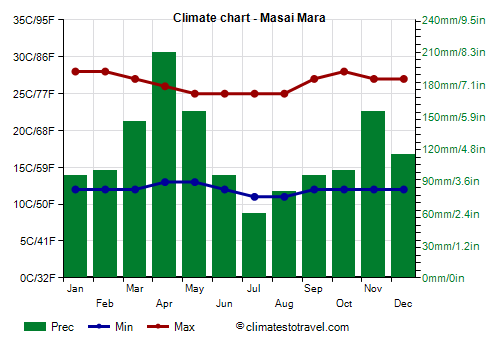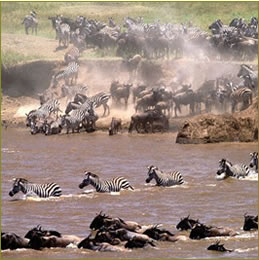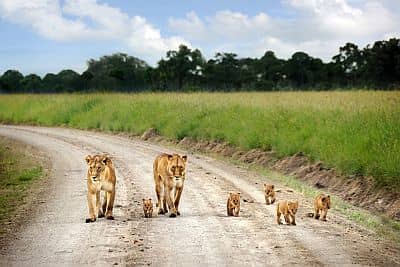Select units of measurement for the temperature and rainfall tables (metric or imperial).
Average weather, temperature, rainfall, sunshine hours

In the Masai Mara National Park, located in southwest Kenya, the climate is
pleasantly warm, with cool nights, all year round. The area is located just south of the Equator, but at an altitude between 1,500 and 1,900 meters (5,000 and 6,200 feet). Temperatures are slightly higher from October to March, while they are slightly cooler from June to August. At night, it can be a bit cold, and the temperature can drop below 10 °C (50 °F), especially from June to August.
Here are the average temperatures.
Masai Mara - Average temperatures|
| Month | Min | Max | Mean |
|---|
| January | 12 | 28 | 20 |
|---|
| February | 12 | 28 | 20 |
|---|
| March | 12 | 27 | 19.5 |
|---|
| April | 13 | 26 | 19.5 |
|---|
| May | 13 | 25 | 19 |
|---|
| June | 12 | 25 | 18.5 |
|---|
| July | 11 | 25 | 18 |
|---|
| August | 11 | 25 | 18 |
|---|
| September | 12 | 27 | 19.5 |
|---|
| October | 12 | 28 | 20 |
|---|
| November | 12 | 27 | 19.5 |
|---|
| December | 12 | 27 | 19.5 |
|---|
| Year | 12 | 26.5 | 19.2 |
|---|
amounts to about 1,400 millimeters (55 inches) per year. The wettest month is April, and the driest is July. In the two rainy seasons (see below), especially in April, the rains are abundant and can cause flooding. Here is the average precipitation.
Masai Mara - Average precipitation| Month | Days |
|---|
| January | 95 | |
|---|
| February | 100 | |
|---|
| March | 145 | |
|---|
| April | 210 | |
|---|
| May | 155 | |
|---|
| June | 95 | |
|---|
| July | 60 | |
|---|
| August | 80 | |
|---|
| September | 95 | |
|---|
| October | 100 | |
|---|
| November | 155 | |
|---|
| December | 115 | |
|---|
| Year | 1405 | |
|---|
To the south, across the border with Tanzania, the park continues in
Serengeti. The whole area is famous for the spectacular
migration of animals, savanna herbivores such as wildebeest and zebras, which move between the two parks, along a circular path throughout the course of the year, in search of pastures made green by the rains, and are preyed upon by lions, hyenas, leopards and cheetahs, while crocodiles and hippos wait for them in the rivers. In fact, in the area, we find the Mara River with its tributaries, some of whose branches are lost in the swamps.

In both parks, there are
two rainy seasons, one that lasts about six weeks and occurs from March to May (called "the long rains"), and the other that lasts about two weeks and occurs from October to December (called "the short rains"). However, between the two adjacent parks, the Serengeti, being located more to the south, remains quite rainy also in January and February, and becomes dry from June to September, while the Mara is quite rainy even from June to September. Therefore, in this period, the animals move from Serengeti to Mara, arriving usually in July, and then go back in October, when the season of the short rains begins in Serengeti. So, there is no real dry season in Masai Mara, though it rains less from June to September, and July is the driest month.
The animals do not move all together, but in herds of tens of thousands of individuals, and their movement can vary from year to year, depending on rainfall, and therefore of pasture availability. However, in Masai Mara, as we mentioned, the animals are usually visible
from July to October, with a higher probability in August and September.
Being that the park is near the Equator, the
sun passes through the zenith at mid-day (that is, directly overhead in the sky) twice a year, in late March and late September, and remains very high above the horizon around noon also in the other months; therefore, it requires appropriate protection, also because of the high altitude.

The amount of
sunshine in Masai Mara is good all year round, since the sky is often clear, although there may be some afternoon cloudiness, which can give rise to showers and thunderstorms, obviously more frequent in the two rainy seasons. Here are the average sunshine hours per day.
Masai Mara - Sunshine hours| Month | Average | Total |
|---|
| January | 9 | 280 |
|---|
| February | 9 | 255 |
|---|
| March | 8 | 250 |
|---|
| April | 7 | 210 |
|---|
| May | 7 | 215 |
|---|
| June | 8 | 240 |
|---|
| July | 7 | 215 |
|---|
| August | 7 | 215 |
|---|
| September | 8 | 240 |
|---|
| October | 8 | 250 |
|---|
| November | 8 | 240 |
|---|
| December | 8 | 250 |
|---|
| Year | 7.8 | 2860 |
|---|
The Masai Mara can be reached by flight, or by a 5-6 hours car trip from Nairobi.
Best Time
The
best time to visit the Masai Mara goes
from June to September, since it is the coolest, and (albeit slightly) the driest period of the year. However, showers in the afternoon may still occur, and there can be a bit of cool weather (or even cold) at night, while it is pleasantly warm during the day.
Alternatively, you can go in January and February, the other relatively dry season, when it's warmer, and as we mentioned, some showers are still possible.
As previously mentioned, the period when the herds of wildebeest and zebras reach the park goes from July to October, with a preference for August and September. October is a bit hotter than the previous months; on the other hand, already in September, there is a certain increase in temperature due to the zenith passage of the sun; so, it can be a bit hot during the day and less cool at night. For the rest, the amount of rainfall is similar to that of the previous months, until the short rains season begins, which can happen in October or November depending on the year.
In January and February, you can watch the local fauna, such as big cats.